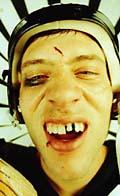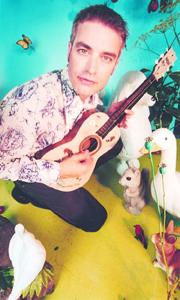IT’S JUST PAST dinnertime on a blustery Sunday night, when most Seattleites are nestling into their living rooms to wait out the last hours before going off to sleep and waking to another workweek. In Lynnwood’s Sno-King Ice Arena, though, a group of thirtysomething men walk through the doors one by one, oversized equipment bags slung over their shoulders. They’re not thinking about sleep or work. They’re thinking about beating the other team. They’re thinking about hockey.
At 8:45, when the puck is dropped at center ice, the Cascade Hockey League men’s senior/no-check B Division game begins, with five skaters dressed in stately maroon battling five skaters dressed in vibrant gold. Through two periods, the goalies spoil the fun, holding a well-played defensive game to a 1-1 tie. Of course, none of the players boast Gretzky’s scalding shot, and the goaltenders don’t sprawl into kick-saves as spryly as Patrick Roy, but these weekend hockey warriors skate, pass, and shoot with surprising acumen and steely determination.
This game, and the dozens of others like it that take place weekly at Sno-King and at ice rinks around the metro area, falls way below the radar of most sports enthusiasts. Hockey’s not an easy sport to master, despite the ignorant assumptions some snobs make about players’ intellects. Nor is it inexpensive; the required gear, including helmet, skates, various pads, sticks, and uniforms, costs upwards of $300. Unlike a tennis, softball, or touch football game, which can be organized with a few hours’ notice, hockey merits a higher level of devotion and planning. Is it worth it?
About 2,500 Seattle-area players think so, according to the co-owner of the Highland Ice Arena in Shoreline, Rick Stephens. He hosts organized league games similar to the CHL’s, but also adult recreational games open to men and women 18 and over. In a chilly variation on the popular pick-up basketball game, three nights per week these games accommodate up to 20 players who come with the proper equipment and $10 cash.
The only catch is that hockey can be addictive. The thrill of gliding around on skates as the cold air rushes past, the charge that comes with a perfectly placed pass meeting the curved wood of the stick, the exquisite satisfaction of a shot flying past the goalie and into the net—nothing in sports compares.
Stephens confirms that hockey can be more than just a hobby or leisure activity. He cites a group of players ranging in age from 35 to upwards of 70 who convene on the ice at Highland every Tuesday night at 9:45 as the Uphill Hockey League, which has been operational since 1964. The elders of the group even team up with seniors from Vancouver, BC, to compete as a Northwest squad in an annual Santa Rosa, California, meet hosted by Peanuts creator and hockey nut Charles Schulz.
Still, Stephens says that the population of committed players has declined markedly from its early ’70s heyday, when the schedule became so crowded that the last team wouldn’t leave the ice until 1:30am; now, it’s a late night when the lights are dimmed by 11:30. He attributes the decline to Seattle’s increasingly frantic work force (though he notes that Boeing and Microsoft both have their own leagues that play at Kingsgate Ice Arena in Kirkland), as well as to the high cost of equipment and the lack of a professional team in the city. (The so-so Thunderbirds of the WHL don’t stack up to the old Seattle Totems team, which won several world championships a few decades back).
The good news is that there’s room to grow. Arenas like the Sno-King, Highland, Puget Sound Hockey Arena, and others host various leagues and pick-up nights. Most have friendly folks a phone call away who can explain what leagues or nights are open, and to what level of player; they’ve also got shops that sell gear.
And if you’re still not convinced that playing hockey is a rush but you enjoy it as a spectator, these arenas offer exciting entertainment, close-up and free.






